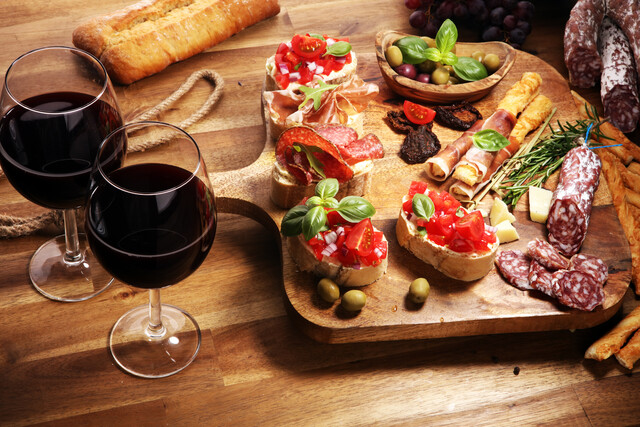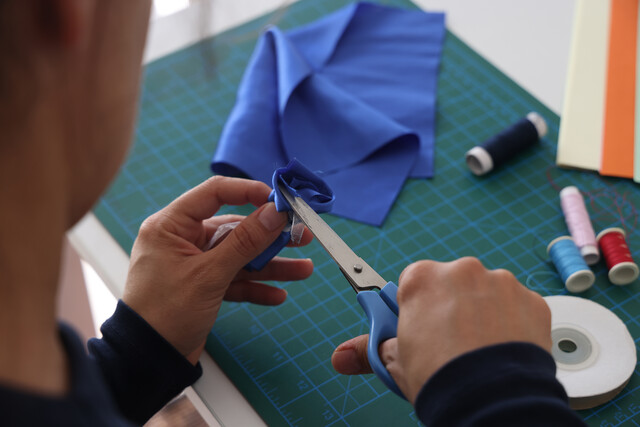Cookie baking, just as any other culinary endeavor, is best-completed with an arsenal of useful instruments which ensure optimal results. There are many kitchen utensils available, and in order to make the best cookies without breaking the bank you must know which are essential and which are not.
Objectives:
1. Learn the differences between different types of mixing bowls.
2. Learn which kitchen tools are most useful for cookie baking.
Mixing Bowls:
There are many different types of materials commonly used for mixing bowls; but the three most common are ceramic, glass, and metal. All three are non-reactive and non-porous, in contrast to materials such as wood, so they do not compromise the flavors of the ingredients. Which one to choose is up to the baker, but there are certain benefits and drawbacks to each. What is most important is to be sure that you have an assortment in sizes ranging from two or three cups to four or five quarts. This will allow you to complete a range of tasks necessary for successful cookie baking: beating eggs, blending dry ingredients, whipping icings, and preparing sugar toppings.
Ceramic:
Glass:
Glass bowls have one major advantage over ceramic and metal variations: they are transparent. This is especially beneficial in cookie baking because they allow the baker to view the batter and assure that all ingredients are thoroughly incorporated. Cookie batter tends to be much thicker than cake or brownie batter. This means that sometimes the thick batter sticks to the sides of the bowl. Glass bowls allow the baker to view the batter while mixing. Glass is oven and microwave safe. Glass bowls are prone to breaking when dropped which is certainly a downside especially if you are cooking with small children.
Metal:
Metal bowls, specifically stainless steel, are widely available in any kitchen supply store and are usually the cheaper alternative to decorative ceramic bowls and impressive glass bowls. They are good for a variety of cooking tasks, but they are NOT microwave safe. Putting a metal bowl in the microwave could result in a catastrophic kitchen fire. Stainless steel bowls get very hot when filled with hot ingredients, and likewise they get equally cold in the opposite situation. Copper bowls are the best conductors of heat, and wonderful for whipping egg whites.
Mixer:
Hand Mixers are great for recipes that require a long mixing time and they are the best at fully incorporating all ingredients. There are three types of mixers that a baker can choose from. The stand mixer is for the ambitious or advanced baker. These are expensive but they can whisk egg whites to peaks, pull bread dough, and whip without stopping. They are beautiful counter pieces for the large kitchen and come in a variety of appealing colors. They do take up a lot of space and may not be the best investment for the hobby baker with a small kitchen. Hand mixers are a mainstay of the American kitchen. They mix and whip at a variety of speeds making them easy to use. They are so common that many recipes are written with them in mind. A stick blender is great for a small kitchen or a baker on a budget. They do basically the same tasks as the standard hand mixer while also retaining swirling blades for blending. These are great little kitchen tools!
Measuring Cup Set:
Measuring cups can be found in any kitchen supply store and even in most grocery stores. They come in ceramic, plastic, glass, metal, silicone, and wooden varieties. Collapsible silicone cups are great for easy storage, but metal cups are the tried and true favorite of most kitchens. They are light, easy to use, and easy to clean. Make sure that your measuring cups have the measurements engraved on the handle. Amounts that are written on the handles can rub off over time which could potentially cause a kitchen mishap. A standard measuring cup set should include ¼ cup, ½ cup, ¹?? cup, and a full cup.
Measuring Cup (Pitcher):
Even if you have a measuring cup set, a glass measuring cup pitcher (up to two cups) is irreplaceable for pouring liquids. Many times a baker will use a measuring cup pitcher for liquids and a cup set for dry ingredients so that the wet and dry ingredients do not stick together and cause inaccurate measurements.
Teaspoon and Tablespoon Set:
Small spoons in a variety of sizes from ¼ teaspoon to a full tablespoon are essential to cookie baking. Most recipes call for baking soda, baking powder, and spices which are so strong that only a tiny amount is needed.
Whisk:
An inexpensive metal whisk is a must-have for any kitchen. When a cookie recipe calls for a beaten or slightly beaten egg, there is no need to get a large mixer dirty with all of its many parts when a whisk would do just fine. These are great for any delicate or small mixing task.
Spoon:
When mixing cookies, one should not use a regular spoon because the batter tends to be quite thick. Thick batter can bend an ordinary spoon. The best choice is a large kitchen spoon made of a strong metal. A regular soup spoon, tablespoon, or ice cream scoop is perfect for drop cookie size.
Spatula:
Not only are these great for incorporating ingredients, inexpensive, and can be used widely in other non-cookie recipes; but they are also perfect for scraping the sides of the mixing bowl to fully incorporate all ingredients.
Cookie Cutter:
These are perfect for cookie baking with children. They love to choose from a collection of designs and wait for "their" cookies to bake. Cookie cutters come in a variety of shapes and are popular for holiday sugar cookies. A cookie cutter shaped like a man is essential for baking gingerbread men.
Cookie Sheets (two or more):
Cookie sheets are generally labeled "non-stick" which means they are coated with Teflon. Make sure you have at least two sheets.
Conclusion:
How to Ensure the Best Outcome
There are good cookies and there are great cookies. The difference is not always in ingredients, but sometimes it lies in technique and method. With the exact same ingredients, one baker could create a perfect cookie while another could end up with a burnt mess. There are a few precautions anyone can take to ensure that each batch is a great batch and every cookie a great cookie.
Objectives:
1. Learn the best ways to prepare ahead for cookie baking.
2. Learn ways to combat problems such as inaccurate oven thermometers.
3. Learn a few tricks to make sure your cookies come out great every time.
Prepare! Prepare! Prepare!
One of the most important aspects of successful cookie baking is preparing ahead of time. It does not matter how great your ingredients are if you forget one of them and have to run to the store while your batter firms, gets too warm, or too cold. The first and possibly most important step in cookie baking is to prepare.
Read your recipe through (completely!) before heading to the store. After reading it through one time, go ahead and make a shopping list. Include any instruments or tools that you may not have on hand at home.
The best way to make the most efficient shopping list is to divide it based on the sections of the store, so you can easily keep track of what you have already picked up and what is yet to be found. This way you should not make the mistake of forgetting the eggs or the butter. It is never fun to have to go back to the store especially at night or around the holidays.
Always follow all the steps:
Many times a novice baker will skim over a recipe, look at the ingredients list, and throw it all into a bowl without regard for the steps involved. This is a one-way ticket to an imperfect batch of cookies. Each step is important in ensuring the best possible outcome, especially for the novice baker. For instance, mixing wet and dry ingredients separately is a way of ensuring that all ingredients are well-incorporated into the batter and that no clumps remain.
Oven Temperature:
Always be aware of your oven temperature! Some ovens run high and others low. It can be problematic if you are unsure of how accurate your oven thermometer really is. You can test the temperature of your oven without a thermometer. All you need is a baking dish and a little bit of granulated sugar.
Oven Temperature Test:
1. Preheat the oven to 375°.
2. Place a large spoonful of granulated sugar on a baking dish.
3. Place dish with sugar in the oven for 15 minutes.
4. If your oven is calibrated correctly, the sugar will melt. If it does not melt, your oven is running cold.
5. Follow the same steps again but with the oven temperature at 350°.
6. This time the sugar should not melt. If it does your oven is running hot.
If you have determined that your oven is calibrated then you are good to go, but if it is running hot or cool you will need repeat the test in 25° increments (up or down) until the sugar melts. This will allow you to be aware of the actual temperature of your oven. If the sugar melts when the thermometer reads 425°, for instance, then you can add 50° every time you bake. If you want to recalibrate the thermometer, most oven manuals have instructions for doing so. Check your temperature often!
Pre-baking Refrigeration:
This step is not always listed on a traditional recipe, but it is in no way unimportant. After mixing a batch of cookies, shape the batter into a ball, place it in a bowl, cover it with plastic wrap, and place it in the refrigerator. This allows for the fats to solidify, so they will spread less in the oven. Your cookies will come out thicker and more appealing after this simple trick. Most traditional cookies, such as chocolate chip or oatmeal, only need one hour in the refrigerator to make a difference. Sugar or peanut butter cookies do well to have two to four hours to solidify before baking. Some bakers even put the cookie tray with unbaked cookies back in the refrigerator for another 15 to 30 minutes before baking because the heat from the hands can warm the dough before it is ready. If you use a spoon and quickly scoop the dough onto the tray you should be able to avoid this secondary refrigeration step.
Utilizing the Oven Light:
An oven light is an excellent tool to have at your disposal in any baking endeavor. Every time you open the oven you release heat. The longer it is open, the more heat is lost. Instead of checking your cookies by opening the oven door, you should always use the oven light. This will allow the oven temperature to stay more or less consistent while baking a batch of cookies.
Parchment Paper is your Friend:
Non-stick cookie sheets are all well and good, but nothing beats a sheet of parchment paper. This allows the baker to lift the cookies within minutes of removing them from the oven in order to place them on a wire cooling rack. If you only have one or two trays, you can (gently) lift the entire sheet of parchment paper with all the cookies on it and replace it with another sheet full of cookies ready to be baked in order to minimize empty oven time.
Thick Chewy Cookies:
There is a general division between people who prefer thick chewy cookies and those who would rather indulge in a thin crispy variety. The majority seem to favor thick cookies, but any batch can be made either thick or thin depending on a few important steps. The first, and most important, would be the oven temperature. A cookie baked at a lower temperature for a longer time will generally retain more of its original shape, staying thicker. Many recipes do specify different temperatures and cook times for the two outcomes. A bit of extra baking soda may add rise to the batter, and always make sure the baking soda is fresh! Even more importantly make sure to whip the butter and sugar for long enough during the mixing process. This incorporates air into the batter and creates a more fluffy and soft cookie. The last step is pre-baking refrigeration, as discussed above. This step cannot be skipped when attempting to bake a batch of thick cookies.
Crispy cookies are great to crumble on top of ice cream or to top with icing. In order to achieve a thin, wafer-like, crispy cookie you will want to follow a few steps. When you are mixing the batter, cream the butter sufficiently as you would with thick cookies. This will allow your cookies to not be too dense. Instead of cooling the dough in the refrigerator for an hour before baking, you can opt to not cool it at all. Make sure the cookie dough balls you place on the cookie sheet are small because they will spread much more than the thicker ones. In order to ensure that the dough spreads quickly in the heat of the oven, use a higher heat for a shorter time. Be careful to look at your recipe and make sure the default temperature is not already set for crispy cookies.
Conclusion:

























